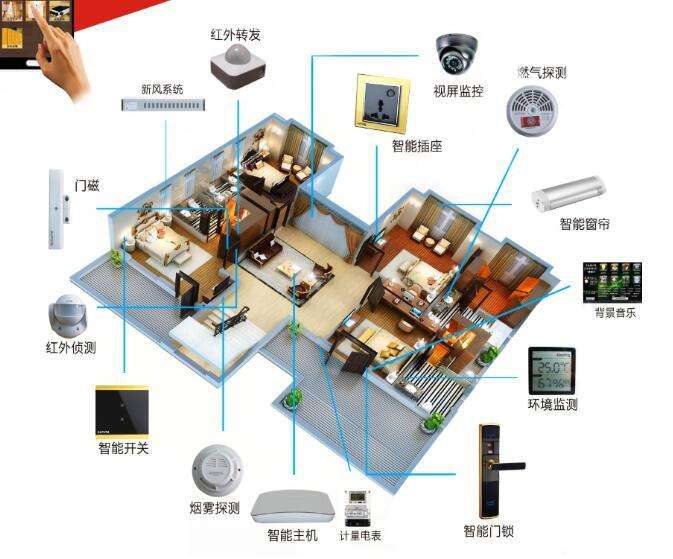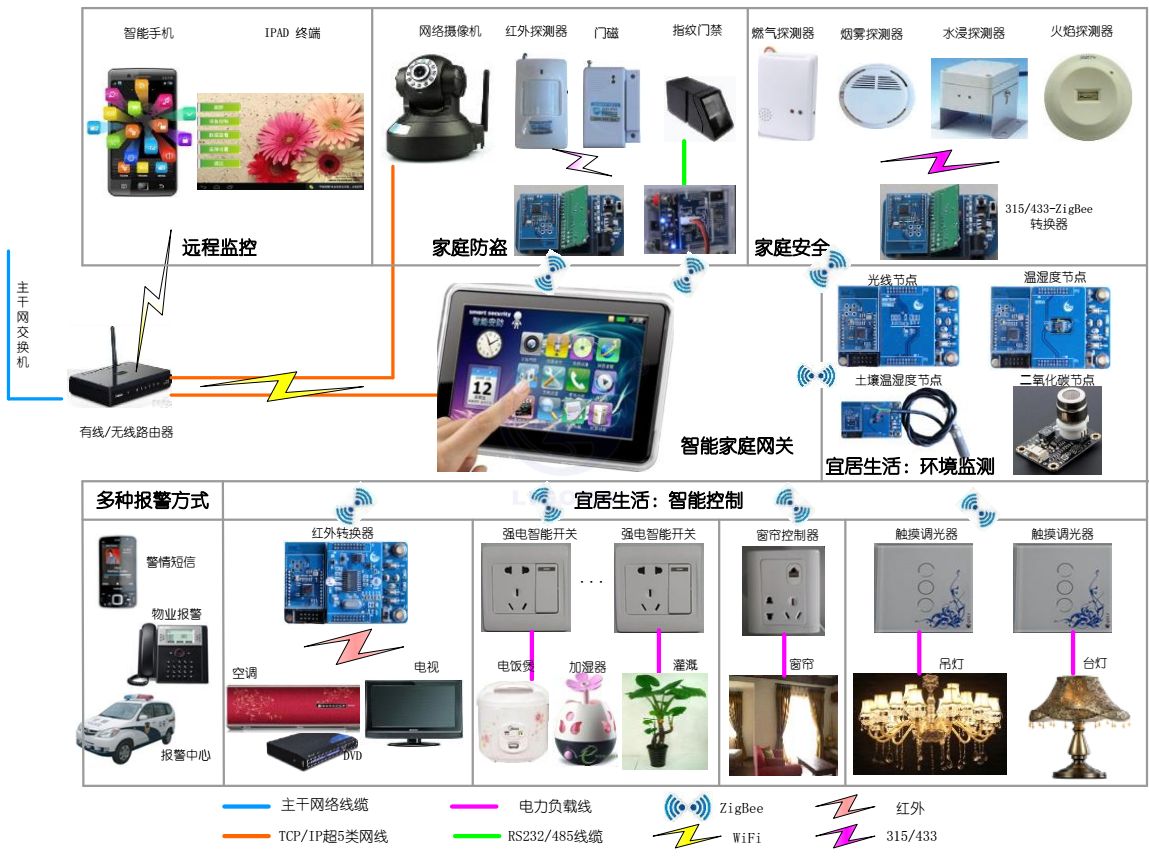
WiFi: in fact, it's another name of IEEE 802.11b. It's an industry term published by an organization called wireless Ethernet Compatibility Alliance (WECA). It's translated into Chinese as "wireless compatibility certification". It is a kind of short-range wireless transmission technology, which can support the radio signal of Internet access within hundreds of meters. Its biggest characteristic is convenient for people to access the Internet anytime and anywhere. However, for smart home applications, the disadvantages are obvious, such as high power consumption and strong networking professionalism. High power consumption is a fatal defect for the deployment of low-power sensors anytime and anywhere, so WiFi is very popular, but it only plays a supplementary role in the application of smart home
ZigBee: ZigBee is based on IEEE 802.15. But IEEE only deals with low-level MAC layer and physical layer protocol, so ZigBee alliance extends IEEE and standardizes its network layer protocol and API. ZigBee is a new kind of short-range, low-speed and low-power wireless network technology, which is mainly used for short-range wireless connection. It has the characteristics of low complexity, low power consumption, low rate, low cost, ad hoc network, high reliability and over the horizon. It is mainly suitable for automatic control, remote control and other fields, and can be embedded in various devices. In short, ZigBee is a cheap, low-power, ad-hoc short-range wireless communication technology.
III. understanding of smart home in the context of Internet of things
ZigBee's initial expected applications include consumer electronics, energy management, health care, home automation, building automation and industrial automation. With the rise of the Internet of things, ZigBee has gained new application opportunities. Sensors or control units are the most widely used network edge applications of the Internet of things. These are the most basic, the most core and the most extensive unit cells that make up the Internet of things. ZigBee can achieve communication among thousands of tiny sensor drive units, and these units only need a little energy to transmit data from a network node to a network node through radio waves by relay Another node, so its communication efficiency is very high. This technology is low-power, anti-interference, high reliability, easy to network, easy to expand, easy to use, easy to maintain, easy to rapid large-scale deployment and other features conform to the requirements and trends of the development of the Internet of things. At present, the application of Internet of things and ZigBee technology in smart home, industrial monitoring and health care has great integration
It is worth noting that the rise of the Internet of things will bring ZigBee a broad market space. Because the purpose of the Internet of things is to combine all kinds of information sensing drive units with the Internet to form a huge network. In this huge network, the transmission of data is needed between the sensing drive unit and the communication network. Compared with other wireless technologies, ZigBee will surely be in the field of Internet of things smart home with its advantages in investment, construction, maintenance, etc It is widely used.
315m / 433M / 868m / 915m: these radio-frequency technologies are widely used in vehicle monitoring, remote control, telemetry, small wireless network, industrial data collection system, wireless label, identity recognition, non-contact RF and other places. Some manufacturers also introduce them into smart home system. However, due to their weak anti-interference ability, inconvenient networking and general reliability, their application effect in smart home is poor and strong Meaning, pan good can be Chen, eventually abandoned by mainstream manufacturers.
IV. scheme selection
As a standard smart home, it needs to cover many applications, but the precondition must be that any ordinary consumer can install, deploy or even expand the application easily and quickly, without the need for professional installation personnel to install on site. A typical smart home system usually requires the following devices:
No. product name model remarks
1 wireless communication gateway wl-gw-a connection network transfer control signal
2 wireless dimming switch wl-ds-a01
3 wireless temperature and humidity sensor wl-th-01
4 wireless intelligent socket wl-ics-a01
5 wireless infrared transponder wl-zrfc-01
6 wireless infrared intrusion detector wl-md-a
7 wireless air quality detector wl-aqd-a01
8 wireless doorbell
9 wireless door and window magnetic sensor wl-dws-01
10 wireless gas valve
11 wireless combustible gas leakage detector wl-gd-a01b
12 wireless automatic curtain wl-wcc-01
Brief description of relevant equipment:
Wireless gateway: it is the information collection and control terminal of all wireless sensors and wireless linkage equipment. All sensors and detectors will transmit the collected information to authorized mobile phones, tablets, computers and other management devices through wireless gateway, and in addition, control commands will be sent by management devices to linkage devices through wireless gateway.
If the door is opened when there is no one at home, and the door magnet detects that someone has intruded, the intruder alarm will be sent to the owner's mobile phone through the wireless gateway, and the mobile phone will send out a vibration bell prompt after receiving the information, and the owner will send out a control command after confirming, and the electromagnetic door lock will automatically lock and trigger the wireless audible and visual alarm to send out an alarm
Wireless intelligent dimming switch: the switch can directly replace the wall switch panel in the home. Through it, it can not only be used as a normal switch, but more importantly, it has automatically formed a wireless sensor control network with all the Internet of things devices in the home, and can send the switch, dimming and other instructions to it through the wireless gateway. The significance is that the owner does not need to worry about whether all the lights in the home have forgotten to turn off after leaving home. As long as the owner leaves home, all the lights that have forgotten to turn off will turn off automatically. Or when you sleep, you don't need to check whether the lights are on one by one. All you need to do is press the sleep button installed at the head of the bed. All the lights will turn off automatically. At the same time, when you get up at night, the lights will automatically adjust to soft, so as to ensure the quality of sleep.
Wireless radiation sensor, wireless air pollution sensor: for some people who are sensitive to solar radiation, this kind of sensor has special significance. Through it, you can accurately know whether you need to take anti solar radiation or anti pollution and dust-proof measures before going out, and the only thing you need to do is look at the mobile phone screen, because the outdoor radiation, pollution and other conditions have passed without The line gateway has reached your mobile phone.
 The above is a typical Internet of things smart home system. Of course, the magic of the Internet of things lies in that you can freely combine or DIY according to your own needs. All the installations don't need the participation of professionals. An ordinary consumer can complete them, while the whole installation process of the system is generally less than half an hour, which is also the product and transmission of the Internet of things smart home An important difference of smart home products.
The above is a typical Internet of things smart home system. Of course, the magic of the Internet of things lies in that you can freely combine or DIY according to your own needs. All the installations don't need the participation of professionals. An ordinary consumer can complete them, while the whole installation process of the system is generally less than half an hour, which is also the product and transmission of the Internet of things smart home An important difference of smart home products.